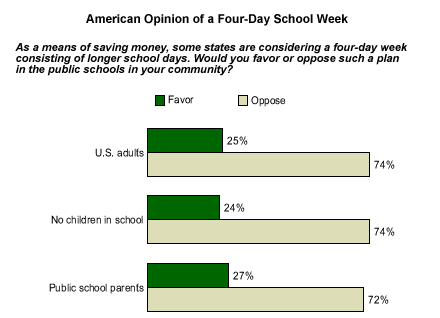This article contains findings from the 35th Annual Phi Delta Kappa/Gallup poll of the Public's Attitudes Toward the Public Schools, released on Aug. 20 in Washington, D.C.
Dire state budget situations across the country have left school districts scrambling to do more -- and do better -- with less money. Many districts are cutting jobs and services, paring curricula, and asking taxpayers to dig deeper. If they still face financial shortfalls after those avenues have been exhausted, some school districts and states consider a far more radical move -- switching from the traditional five-day school week to a four-day week with longer days.
Although Americans name financial and funding issues as the top problem facing public schools in their communities (see "Americans Stay True to Their Local Schools" in Related Items), they aren't looking to solve those problems with a four-day week and longer days. According to the 2003 PDK/Gallup poll*, only 25% of Americans favor the idea as a means of saving money, while 74% oppose it. Support is similarly low among parents of public school children and people without children in school.

Ideally, the four-day school week saves schools a day's worth of costs in transportation, utilities, and staff expenses. What savings this translates to varies from school district to school district, but any money saved may mean funds can be redirected into areas that need them. And some schools already on a four-day schedule claim non-financial benefits as well, such as fewer student and teacher absences.
Four Days? No Way
Americans' opposition to the four-day week may stem from a number of sources. Many may not be familiar with the four-day concept, and are hesitant to embrace an idea that breaks with the tradition of the five-day week. However, the concept of an abbreviated school week is not so new and some school districts have been using it for years. The concept of a four-day week was first introduced in New Mexico in 1972, as a way to reduce transportation costs and cut electric bills during the energy crisis. Today, roughly 100 school districts, mainly in rural areas, follow a four-day schedule.
The economic and logistical demands of additional childcare represent another likely factor in many Americans' opposition to a shortened school week. A four-day week means an extra full day of childcare for parents who work a traditional five-day week. Some rural schools turn to older students to combat the childcare issue, training older students to be babysitters for younger students on the fifth day.
Location, Location, Location
Many education experts agree that while the four-day week may work in a rural setting or in a small district, it may not work as well in larger districts and urban areas. Given the fact that most schools currently on four-day schedules are in rural areas, one might expect a higher level of support among rural residents. However, the PDK/Gallup data do not show a significant difference among suburbanites, city dwellers, or rural residents. Twenty-three percent of residents of urban areas favor a four-day week with longer days, as do 27% of suburbanites and 24% of rural residents.
Bottom Line
The current budget crisis comes at a time when schools face the additional pressures of standardized testing and performance requirements of No Child Left Behind. Do students attending schools on four-day schedules perform better or worse academically? It is hard to draw any firm conclusions because the available data are limited. An article in the School Board News examined two districts, and found one school district's ACT scores rose above state averages after switching to the four-day week, while another school district's achievement levels remained relatively flat.
*Findings are based on telephone interviews with a random sample of 1,011 U.S. adults, aged 18 and older, conducted from May 28 to June 18, 2003. For results based on this sample, one can say with 95% confidence that the maximum error attributable to sampling and other random effects is ±3 percentage points.